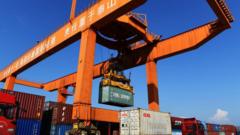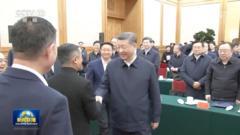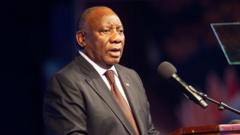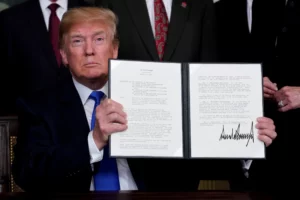As the trade conflict between the US and China intensifies, Beijing has announced a series of retaliatory measures targeting specific American goods, including fossil fuels, agricultural equipment, and tech giants. This article explores the implications and strategic motivations behind these actions.**
**China's Strategic Retaliation Against US Tariffs: An In-Depth Look**

**China's Strategic Retaliation Against US Tariffs: An In-Depth Look**
**Analyzing China's Various Responses to US Tariffs Amidst Ongoing Trade Tensions**
The escalating trade conflict between the United States and China has prompted Beijing to counter the implementation of new tariffs by the US with its own set of retaliatory measures. Following the US's introduction of a blanket 10% tariff on all Chinese imports, China is focusing on specific American goods, revisiting their longstanding trade tensions that date back to 2018. President Trump has indicated he might engage in discussions with Chinese President Xi Jinping, raising the possibility of a negotiated resolution. If China follows through with its 10 February actions, the implications could be significant.
One of the prominent counteractions includes new tariffs on oil and coal imports, with a 10% tax on liquefied natural gas (LNG) and a 15% levy imposed on crude oil. This move targets US fossil fuel suppliers, who will now face increased costs in exporting to China. While China stands as the largest global importer of coal, the majority of its imports come from Indonesia and other countries, suggesting that the diversification of supply routes may mitigate the economic impact resulting from US tariffs. Rebecca Harding, a trade economist, notes that China can easily acquire cheaper oil from Russia, where economic strains are prompting attractive pricing strategies.
In addition to fossil fuels, China has enacted a 10% tariff on imports of agricultural machinery, pick-up trucks, and large cars. However, the volume of US pick-up trucks and cars entering China has been relatively low. China's investment in domestic agriculture and machinery appears aimed at reducing its reliance on foreign imports while bolstering its own agricultural capabilities. Julian Evans-Pritchard of Capital Economics argues that China's targeted measures represent a modest response relative to the more substantial tariffs from the US, effectively trying to signal resolve without inflicting severe economic pain.
Another non-tariff approach is the initiation of an anti-monopoly investigation into Google. Despite Google's diminished market presence in China since its services were restricted a decade ago, this probe reflects growing tensions with American technology firms, signaling a potential pushback against US influence. Furthermore, international brands like Calvin Klein are facing challenges, as their addition to China's "unreliable entity" list could hinder their operations and expose them to regulatory scrutiny. Academic insights suggest these retaliations mirror US actions and are part of a broader decoupling strategy between both nations.
Lastly, China has implemented export controls on 25 rare metals, essential for key industries, including electronics and military applications. Although China exports a multitude of these metals, the US sources certain critical components from China, leaving a gap in potential retaliatory strategies. Overall, the current landscape of tariffs and trade measures hints at a complex negotiation environment as both nations recalibrate their strategies moving forward, with far-reaching repercussions for global economics.
One of the prominent counteractions includes new tariffs on oil and coal imports, with a 10% tax on liquefied natural gas (LNG) and a 15% levy imposed on crude oil. This move targets US fossil fuel suppliers, who will now face increased costs in exporting to China. While China stands as the largest global importer of coal, the majority of its imports come from Indonesia and other countries, suggesting that the diversification of supply routes may mitigate the economic impact resulting from US tariffs. Rebecca Harding, a trade economist, notes that China can easily acquire cheaper oil from Russia, where economic strains are prompting attractive pricing strategies.
In addition to fossil fuels, China has enacted a 10% tariff on imports of agricultural machinery, pick-up trucks, and large cars. However, the volume of US pick-up trucks and cars entering China has been relatively low. China's investment in domestic agriculture and machinery appears aimed at reducing its reliance on foreign imports while bolstering its own agricultural capabilities. Julian Evans-Pritchard of Capital Economics argues that China's targeted measures represent a modest response relative to the more substantial tariffs from the US, effectively trying to signal resolve without inflicting severe economic pain.
Another non-tariff approach is the initiation of an anti-monopoly investigation into Google. Despite Google's diminished market presence in China since its services were restricted a decade ago, this probe reflects growing tensions with American technology firms, signaling a potential pushback against US influence. Furthermore, international brands like Calvin Klein are facing challenges, as their addition to China's "unreliable entity" list could hinder their operations and expose them to regulatory scrutiny. Academic insights suggest these retaliations mirror US actions and are part of a broader decoupling strategy between both nations.
Lastly, China has implemented export controls on 25 rare metals, essential for key industries, including electronics and military applications. Although China exports a multitude of these metals, the US sources certain critical components from China, leaving a gap in potential retaliatory strategies. Overall, the current landscape of tariffs and trade measures hints at a complex negotiation environment as both nations recalibrate their strategies moving forward, with far-reaching repercussions for global economics.



















